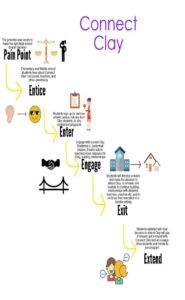Meant to address the prototype setting, tenets of testing, and feedback activities for our three major ideation focuses.
Connect Clay: The Bridge Program
Consider the Setting –
The setting for this solution is Clay High School. The goal is to expose our “target user” – middle school students– to all that Clay has to offer. The more time those middle school students spend at Clay, with Clay mentors, with Clay teachers, in Clay programs, the more likely they are to develop a desire to attend CHS. Human nature is to tend towards continuity, so we must provide that continuity and we must build that bond. Connect Clay is the way to do that.
Define What to Test:
With the Connect Clay program, we need to assess whether or not students would be willing to participate in the programs, and if it would affect the way that they think about Clay.
Questions:
Would going to a program like this improve your perception of Clay?
Would you tell your parents about a program like this?
Would you like to participate in such a program? If not, what kind of program would you like to see?
Define Feedback Activities:
In order to gather this feedback, we could put out interest surveys about these hypothetical programs.
We could station ourselves in a public space (grocery store area? Public library?) and ask passersby if they would be interested in participating in the programs to extract community opinions.
Conduct “exit” interviews with seniors at Clay to see if they would have liked such programming.
Video Marketing Approach:
Consider the Setting –
The Video Marketing Approach that we will be taking takes place at any platform where video can be played, from informational sessions to social media.
Ideally, it will be shown in the classrooms at Clay and at local middle schools.
Finally, we want the video to be posted on social media platforms, reaching students and parents through word of mouth.
Define What to Test –
Whether a video will have any impact on what potential Clay students and parents think about CHS. What kinds of impact might it have? Will people believe the video?
If other parents, neighbors, family friends sent their children to CHS, would that affect your opinion of CHS? Would you consider sending your child to Clay as a result?
Ask administrators if such a program is possible? Ask parents if they would be willing to help out with such a program? See if any FTT students would be interested in overseeing project.
- Questions:
- What did you think of the video’s message?
- What setting did you view the video in?
- Does the video help you change your perception of Clay?
Define Feedback Activities:
Conduct a survey following the presentation of the video to ask about effectiveness.
Play the video for non-CHS students and ask them if they would go to school there?
Ask middle school students if a video might have impacted their school choice?
Offering Opportunities // Building a Better CHS
Consider the Setting –
Building a Better CHS has to do with utilizing the school’s current art resources, its students to make the school environment be one that students will want to study in. Thus, the setting is within the school, and the people involved in this setting are the current CHS students.
Define What to Test –
We need to test how students would feel about the changes to their learning environment/school? Also if they would have a more positive outlook on Clay if they were proud of how their school looked.
- Questions:
- Would students be interested in participating in this project?
- Does the way the school looks influence how a student feels about the school?
- Do the students want more color in their hallways?
Define Feedback Activities:
Survey the current students on their thoughts on the state of the school.
Find pictures from other schools that have creative/colorful environments and show those to current students to gather their opinions.
User value Criteria:
- Availability of relatable touchpoints
- Accessibility
- Effectiveness of engagement
Provider value Criteria:
- Ability to monitor progress and performance
- Cost-friendliness
- Ease of implementation
Solution Evaluation Matrix:
User Value Criteria
|
Relatability |
Accessibility |
Engagement |
Total |
| Connect Clay |
4 |
4 |
5 |
13 |
| Building CHS |
2 |
4 |
4 |
10 |
| Video |
3 |
5 |
3 |
11 |
Provider Value Criteria
|
Monitor |
Cost |
Ease |
Total |
| Connect Clay |
4 |
4 |
2 |
10 |
| Building CHS |
5 |
3 |
3 |
11 |
| Video |
2 |
4 |
3 |
9 |

